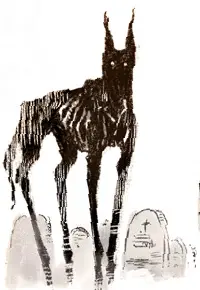Barfoot draws from folk horror, both in setting and storytelling, for his unique creature feature. That means that the horror builds slowly, relying on atmosphere and the isolated, stunning wooded setting to create unease as Lewis and Laura struggle with their loss. Neither handle it well; the quiet Lewis has retreated into himself as Laura relies heavily on their wine cellar to cope with the empty nights. It’s an emotionally fraught environment perfect for horror to take root, further sowing division between son and stepmom.
That horror comes slowly, with Barfoot strategically escalating the creature’s invasion. When the creature does appear, always obscured enough to retain mystery, it’s effectively chilling. The filmmaker has a strong sense of editing that only enhances the visceral terror of the entity, though he is prone to pulling punches. The action cuts away on more than one occasion just as Barfoot dangles the possibility of full-throttle horror, opting instead to preserve the enigmatic nature of this particular creature…
… Daddy’s Head is handsomely crafted, with a creature design that’s pure nightmare fuel. Barfoot knows exactly how and when to employ it for maximum discomfort, though he is prone to cutting the horror scenes too early. The final coda, while sweet, doesn’t quite hit its intended note, either. Barfoot isn’t interested in spelling out everything, working heavily in its favor. While that ultimately makes for a sparser story, it’s one that rewards more depending on how much work you’re willing to put in as a viewer to decipher its details and clues. Whether you’re on this movie’s wavelength or not, one thing is certain: Daddy’s Head is creepy as hell.


